
Steller sea lion underwater, Norris Rocks, Hornby Island, British Columbia, Canada.
Species: Steller sea lion, Eumetopias jubatus
Location: Hornby Island, British Columbia, Canada
Image ID: 32672
Species: Steller sea lion, Eumetopias jubatus
Location: Hornby Island, British Columbia, Canada
Image ID: 32672
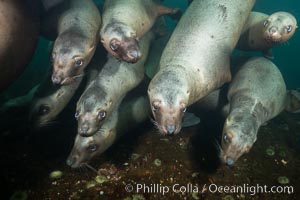
Steller sea lions underwater, Norris Rocks, Hornby Island, British Columbia, Canada.
Species: Steller sea lion, Eumetopias jubatus
Location: Hornby Island, British Columbia, Canada
Image ID: 32673
Species: Steller sea lion, Eumetopias jubatus
Location: Hornby Island, British Columbia, Canada
Image ID: 32673
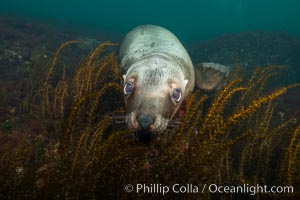
Steller sea lion underwater, Norris Rocks, Hornby Island, British Columbia, Canada.
Species: Steller sea lion, Eumetopias jubatus
Location: Hornby Island, British Columbia, Canada
Image ID: 32674
Species: Steller sea lion, Eumetopias jubatus
Location: Hornby Island, British Columbia, Canada
Image ID: 32674
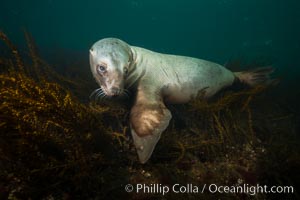
Steller sea lion underwater, Norris Rocks, Hornby Island, British Columbia, Canada.
Species: Steller sea lion, Eumetopias jubatus
Location: Hornby Island, British Columbia, Canada
Image ID: 32675
Species: Steller sea lion, Eumetopias jubatus
Location: Hornby Island, British Columbia, Canada
Image ID: 32675
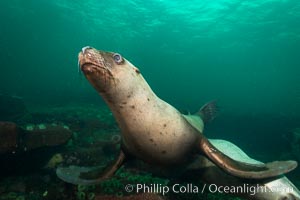
Steller sea lion underwater, Norris Rocks, Hornby Island, British Columbia, Canada.
Species: Steller sea lion, Eumetopias jubatus
Location: Hornby Island, British Columbia, Canada
Image ID: 32676
Species: Steller sea lion, Eumetopias jubatus
Location: Hornby Island, British Columbia, Canada
Image ID: 32676
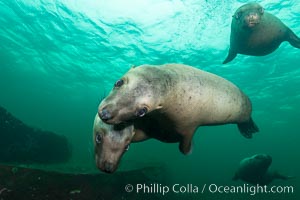
Steller sea lions underwater, Norris Rocks, Hornby Island, British Columbia, Canada.
Species: Steller sea lion, Eumetopias jubatus
Location: Hornby Island, British Columbia, Canada
Image ID: 32677
Species: Steller sea lion, Eumetopias jubatus
Location: Hornby Island, British Columbia, Canada
Image ID: 32677
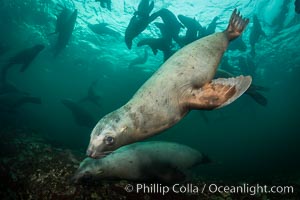
Steller sea lions underwater, Norris Rocks, Hornby Island, British Columbia, Canada.
Species: Steller sea lion, Eumetopias jubatus
Location: Hornby Island, British Columbia, Canada
Image ID: 32678
Species: Steller sea lion, Eumetopias jubatus
Location: Hornby Island, British Columbia, Canada
Image ID: 32678
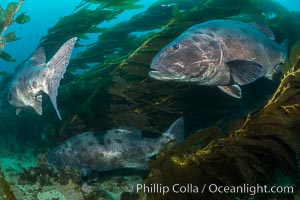
Three giant black sea bass, gathering in a mating/courtship aggregation amid kelp forest at Catalina Island. In summer months, black seabass gather in kelp forests in California to form mating aggregations. Courtship behaviors include circling of pairs of giant sea bass, production of booming sounds by presumed males, and nudging of females by males in what is though to be an effort to encourage spawning.
Species: Giant black sea bass, Stereolepis gigas
Location: Catalina Island, California
Image ID: 33355
Species: Giant black sea bass, Stereolepis gigas
Location: Catalina Island, California
Image ID: 33355
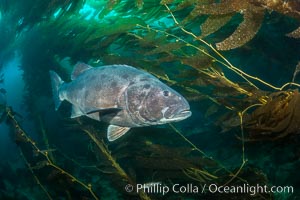
Giant Black Sea Bass with Unique Pattern of Black Spots at Catalina Island. The giant sea bass is an endangered species reaching up to 8' in length and 500 lbs, amid giant kelp forest.
Species: Giant black sea bass, Stereolepis gigas
Location: Catalina Island, California
Image ID: 33356
Species: Giant black sea bass, Stereolepis gigas
Location: Catalina Island, California
Image ID: 33356
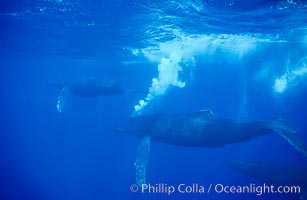
Adult male humpback whale bubble streaming underwater. The male escort humpback whale seen here is emitting a curtain of bubbles as it swims behind a female (left) during a competitive group. The bubble curtain may be meant as warning or visual obstruction to other male whales interested in the mother.
Species: Humpback whale, Megaptera novaeangliae
Location: Maui, Hawaii
Image ID: 02828
Species: Humpback whale, Megaptera novaeangliae
Location: Maui, Hawaii
Image ID: 02828
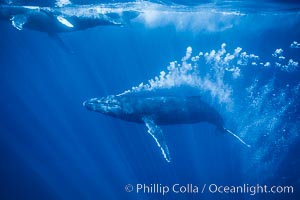
Adult male humpback whale bubble streaming underwater. The male escort humpback whale seen here is emitting a curtain of bubbles as it swims behind a mother and calf. The bubble curtain may be meant as warning or visual obstruction to other nearby male whales interested in the mother.
Species: Humpback whale, Megaptera novaeangliae
Location: Maui, Hawaii
Image ID: 05925
Species: Humpback whale, Megaptera novaeangliae
Location: Maui, Hawaii
Image ID: 05925
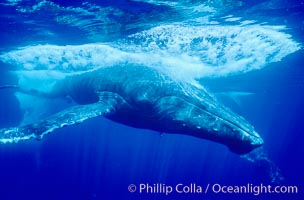
North Pacific humpback whale, escort in competitive group makes fast close pass.
Species: Humpback whale, Megaptera novaeangliae
Location: Maui, Hawaii
Image ID: 06057
Species: Humpback whale, Megaptera novaeangliae
Location: Maui, Hawaii
Image ID: 06057

Blue whale, raising fluke prior to diving for food, fluking up, lifting tail as it swims in the open ocean foraging for food.
Species: Blue whale, Balaenoptera musculus
Location: San Diego, California
Image ID: 40608
Species: Blue whale, Balaenoptera musculus
Location: San Diego, California
Image ID: 40608
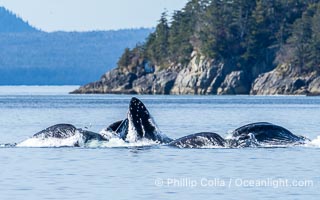
Humpback whales bubblenet feeding in Southeast Alaska. Coordinated bubble-net feeding is a specialized cooperative feeding technique used by humpback whales, where a group of whales works together to trap fish or krill in a net of bubbles then lunge through to feed.
Species: Humpback whale, Megaptera novaeangliae
Location: Sitka Sound, Alaska
Image ID: 40922
Species: Humpback whale, Megaptera novaeangliae
Location: Sitka Sound, Alaska
Image ID: 40922

Humpback Whale Raising Fluke Before Diving in Southeast Alaska.
Species: Humpback whale, Megaptera novaeangliae
Location: Sitka Sound, Alaska
Image ID: 40949
Species: Humpback whale, Megaptera novaeangliae
Location: Sitka Sound, Alaska
Image ID: 40949
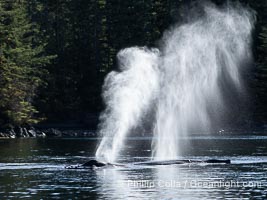
Humpback whale breath hanging in cold still air, Southeast Alaska.
Species: Humpback whale, Megaptera novaeangliae
Location: Sitka Sound, Alaska
Image ID: 40964
Species: Humpback whale, Megaptera novaeangliae
Location: Sitka Sound, Alaska
Image ID: 40964

Humpback Whale Breaching near Tahiti and Moorea, French Polynesia.
Species: Humpback whale, Megaptera novaeangliae
Location: Moorea, French Polynesia, France
Image ID: 41338
Species: Humpback whale, Megaptera novaeangliae
Location: Moorea, French Polynesia, France
Image ID: 41338

Aerial photo of gray whale calf and mother. This baby gray whale was born during the southern migration, far to the north of the Mexican lagoons of Baja California where most gray whale births take place.
Species: Gray whale, Eschrichtius robustus
Location: San Clemente, California
Image ID: 29017
Species: Gray whale, Eschrichtius robustus
Location: San Clemente, California
Image ID: 29017
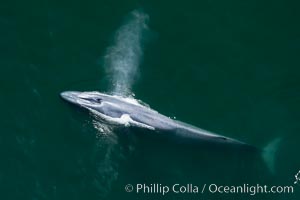
Blue whale, exhaling as it surfaces from a dive, aerial photo. The blue whale is the largest animal ever to have lived on Earth, exceeding 100' in length and 200 tons in weight.
Species: Blue whale, Balaenoptera musculus
Location: Redondo Beach, California
Image ID: 25951
Species: Blue whale, Balaenoptera musculus
Location: Redondo Beach, California
Image ID: 25951

Male elephant seal rears up on its foreflippers and bellows to intimidate other males and to survey its beach territory. Winter, Central California.
Species: Elephant seal, Mirounga angustirostris
Location: Piedras Blancas, San Simeon, California
Image ID: 15521
Species: Elephant seal, Mirounga angustirostris
Location: Piedras Blancas, San Simeon, California
Image ID: 15521

A great white shark swims toward the photographer. Perhaps the shark is considering him as possible prey? The photographer, a "shark diver" is safely situated in a sturdy metal cage. The best location in the world to "shark dive" to view great white sharks is Mexico's Guadalupe Island.
Species: Great white shark, Carcharodon carcharias
Location: Guadalupe Island (Isla Guadalupe), Baja California, Mexico
Image ID: 19457
Species: Great white shark, Carcharodon carcharias
Location: Guadalupe Island (Isla Guadalupe), Baja California, Mexico
Image ID: 19457
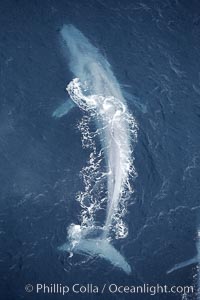
Blue whale. The entire body of a huge blue whale is seen in this image, illustrating its hydronamic and efficient shape.
Species: Blue whale, Balaenoptera musculus
Location: La Jolla, California
Image ID: 21251
Species: Blue whale, Balaenoptera musculus
Location: La Jolla, California
Image ID: 21251

Blue whale. The entire body of a huge blue whale is seen in this image, illustrating its hydronamic and efficient shape.
Species: Blue whale, Balaenoptera musculus
Location: La Jolla, California
Image ID: 21252
Species: Blue whale, Balaenoptera musculus
Location: La Jolla, California
Image ID: 21252

A great white shark swims underwater through the ocean at Guadalupe Island.
Species: Great white shark, Carcharodon carcharias
Location: Guadalupe Island (Isla Guadalupe), Baja California, Mexico
Image ID: 21346
Species: Great white shark, Carcharodon carcharias
Location: Guadalupe Island (Isla Guadalupe), Baja California, Mexico
Image ID: 21346
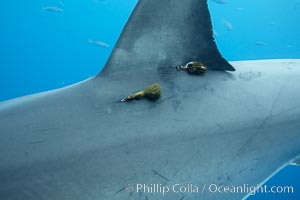
Two satellite tags, below dorsal fin of great white shark. The tags record the sharks movements, relaying data to researchers via satellite.
Species: Great white shark, Carcharodon carcharias
Location: Guadalupe Island (Isla Guadalupe), Baja California, Mexico
Image ID: 21391
Species: Great white shark, Carcharodon carcharias
Location: Guadalupe Island (Isla Guadalupe), Baja California, Mexico
Image ID: 21391

Blue whale and San Onofre Nuclear Power generating station, raising fluke prior to diving for food, fluking up, lifting its tail as it swims in the open ocean foraging for food.
Species: Blue whale, Balaenoptera musculus
Location: Dana Point, California
Image ID: 27337
Species: Blue whale, Balaenoptera musculus
Location: Dana Point, California
Image ID: 27337
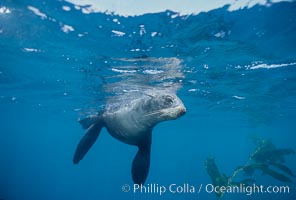
Northern fur seal swims through the cold waters and kelp forest of San Miguel Island, in California's northern Channel Islands.
Species: Northern fur seal, Callorhinus ursinus
Location: San Miguel Island, California
Image ID: 00966
Species: Northern fur seal, Callorhinus ursinus
Location: San Miguel Island, California
Image ID: 00966
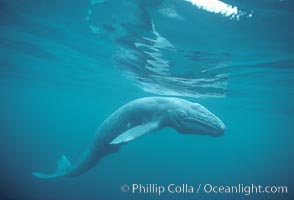
A neonate gray whale calf, born just hours before, still exhbiting embryonic folds in the skin along its side. This baby gray whale was born in the cold waters of Big Sur, far to the north of the Mexican lagoons of Baja California where most gray whale births take place.
Species: Gray whale, Eschrichtius robustus
Location: Monterey, California
Image ID: 01135
Species: Gray whale, Eschrichtius robustus
Location: Monterey, California
Image ID: 01135
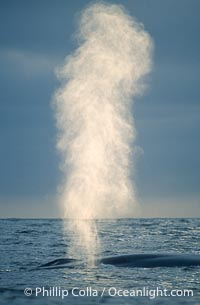
A blue whale spouts at sunset. The blow, or spout, of a blue whale can reach 30 feet into the air. The blue whale is the largest animal ever to live on earth.
Species: Blue whale, Balaenoptera musculus
Image ID: 02217
Species: Blue whale, Balaenoptera musculus
Image ID: 02217

Galapagos sea lion playing with puffer fish.
Species: Galapagos sea lion, Zalophus californianus wollebacki, Zalophus californianus wollebaeki
Location: Cousins, Galapagos Islands, Ecuador
Image ID: 02252
Species: Galapagos sea lion, Zalophus californianus wollebacki, Zalophus californianus wollebaeki
Location: Cousins, Galapagos Islands, Ecuador
Image ID: 02252